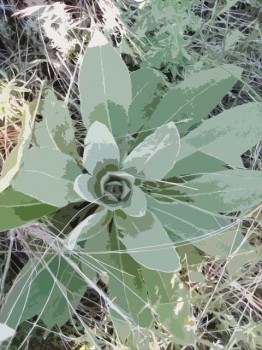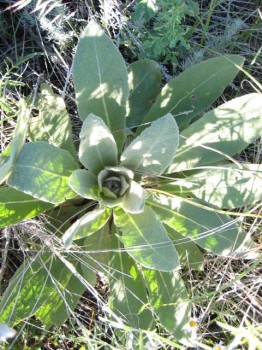
A few weeks ago I received a kindly offer of homemade botanical paper from a mullein-loving kindred spirit who uses it to flavor her paper. How could I say no to that?
When the paper arrived I was charmed thrice over—first by the thought, then by the lovely 4” x 4” pieces of mullein paper themselves, and finally, by the message regarding the messages the “Papers of Intent” are intended to convey.
They are handmade by Stefanie Kompathoum aka Oakmother for “prayers, wishes, contracts, affirmations, ritual, ceremony, and when you want your words to carry special meaning.” The paper is made of 100% post consumer recycled content and is packaged in biodegradable materials, so that sounds like pretty good karma to me.
This particular batch is mullein-flavored—since what we connected over in the first place was mullein (Verbascum thapsis)—one warm and fuzzy mullein celebration in particular.
“Take courage with mullein,” the label states. It “protects from wild animals, evils spirits, negativity and nightmares.” (This is excellent timing, as the evening news in addition to Gregg’s absence have me obsessively locking the doors in this deep, dark forest where I live; plus I’m afraid of wild animals too—specifically, Henry, the bear, destroying the bird feeders while I sleep.)

I have a small square of mullein paper in front of me as I write this, pausing now and again to caress it—my own manner of ritual, I suppose. It is smooth on one side and textured on the other, with flecks of browns and yellows like little toasted spots on a white cracker—which kind of makes me want to eat it.
“I’m interested in the ways we relate to plants—as food, medicine, inspiration, companions, magical allies, and raw materials for art and industry,” Oakmother says. “My life is enriched by knowing the individual plants and what they can do, or what attributes we give them.” In addition to mullein, she uses lavender “for peace and love” or saffron “for admiration and beauty” among other meaningful herb inclusions. This year she foraged mulberry limbs to include in her paper.
To prepare the plants for paper-making, she separates the cellulose fibers, often by cooking in an alkali solution. “The fibers are then beaten so that they expand and spread out when put in water. When strained out, the fibers link together and dry into a solid sheet or form.” For the recycled paper component, “the cooking and beating have been done already, and it’s just a quick trip through the blender with some water to rehydrate the fibers and it’s ready to go.” Stefanie teaches workshops, does demonstrations at farm markets and craft shows near her home base of Hendersonville, North Carolina, and makes and sells the mold and deckle used to strain out the fibers and form the sheets too. Her Papers of Intent, along with cards, pulp paintings, scrapbook assortments, and other handmade items, are available online at Etsy.
“You can’t eat paper, as it’s only the cellulose fiber from the plant, and not the other nutrients or plant material,” she writes me, in answer to my question. Meanwhile I’ve sucked through a third of the paper square I was formerly fondling, turning it back into the pulp from whence it came. It doesn’t taste that good, but I am happy and writing successfully right now, so something must be working.
Although she does not subsist on wild-plant-made paper, Stefanie does enjoy foraging for some of her food, with wild edible favorites including violets, dandelions, wood sorrel, and red root or New Jersey Tea.
As for this piece of half-sucked paper, I’ve decided it’s going on the drying rack next to the Leccinums, angelica, and assorted conifer tips. Once it dries out, I’m going to put it under my pillow for a week of restful sleep and good dreams.

Leave a Reply